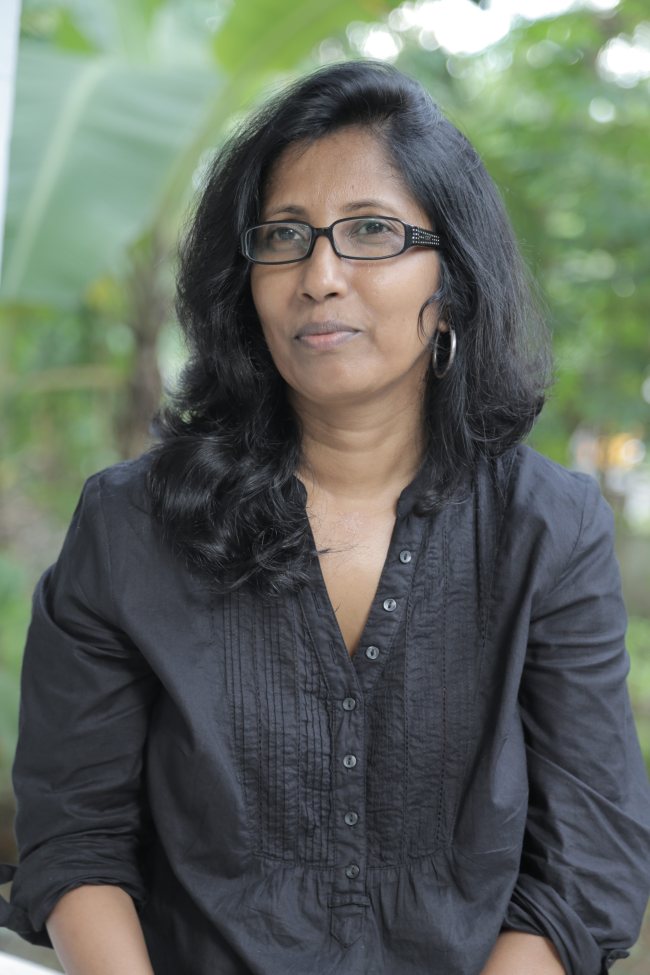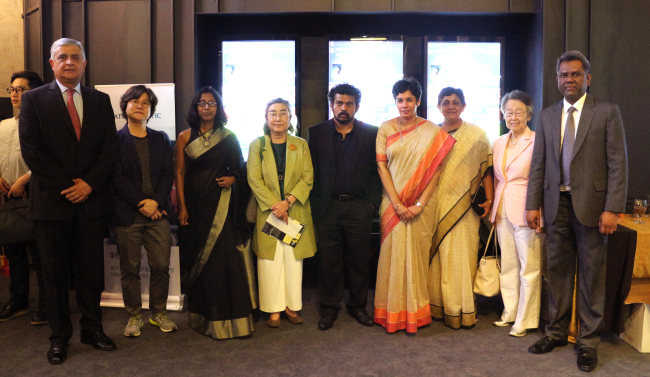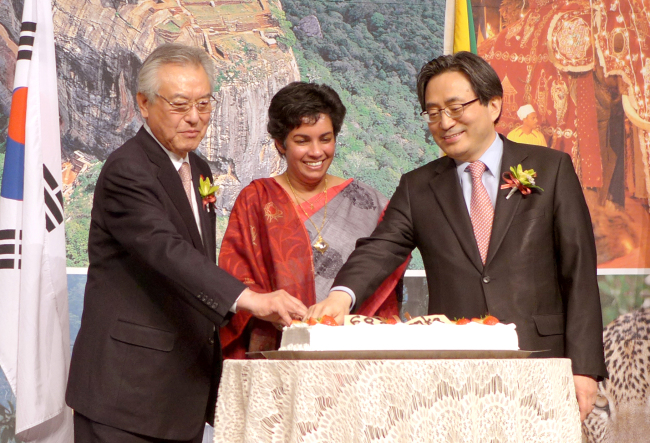The film “Let Her Cry,” a tantalizing tale of an extramarital affair between an old professor and his seductive student, might not have been shown on screens in Sri Lanka a decade ago.
Works that were hostile to the government or provocative in nature were banned by the previous administration, which ruled the country tightly nearing the end of a 30-year interethnic war.
But since the new national unity government of President Maithripala Sirisena and Prime Minister Ranil Wickremesinghe assumed office in 2015, the social ambiance has relaxed and people are more open-minded about iconoclastic expression.
 |
A scene from the film “Let Her Cry,” a tantalizing tale of an extramarital affair between an old professor and his seductive student (Let Her Cry) |
The film, directed by Asoka Handagama, portrays a complex web of psychological and physical interactions involving the professor and his young, bewitching student, and his devout wife, who all become distraught and caught between their carnal desires and moral obligations. Produced in 2015, the movie is set against the backdrop of modern Sri Lanka, still coming to grips with its postwar wounds and new societal challenges.
“My early films dealt with larger social issues of the war, gender and ethnic tensions, but this one is an experiment in a microscopic introspection of a modern Sri Lankan family, dealing with micro rather than macro issues,” the director told The Korea Herald during the Sri Lankan Film Festival. The event was hosted by the Sri Lankan Embassy in Seoul and Korea Foundation.
“The contemporary society is run by wanton, material desires and people are chasing one another. But such symptoms operate on both macro and micro levels. I have attempted to draw a larger picture of the society through my psychoanalytical film.”
The audience reception has been generally positive, he said, mentioning that a famed 75-year-old singer married a 35-year-old woman following the movie’s release, which some people attributed to the storyline. “Things are changing. Society is becoming more liberal,” the filmmaker said.
 |
Sri Lankan film director Asoka Handagama (Asoka Handagama) |
Under the current liberal political climate, the country’s market has also become liberalized and unregulated, Handagama explained. “The irony of all this is that we now have to compete with Hollywood and Bollywood head-on.”
He continued by saying, “We have much more freedom to express our ideas, but it is also challenging to stay afloat in an industry dominated by big money and influence. Our principal challenge is to get our independent films released in theaters.”
Anomaa Rajakaruna, an independent curator who organized the Sri Lankan film festival in late June as part of celebrations marking the 40th anniversary of diplomatic ties between Sri Lanka and Korea, said freedom has increased for artists and writers, who were previously confined to the straitjacket of censorship.
Moving on from the government that banned certain films or cut parts of them, now the public film board classifies works according to age and content, she said.
 |
Independent curator Anomaa Rajakaruna organized the Sri Lankan film festival in Seoul in late June (Sri Lankan Embassy) |
The multiplex theater CGV Myeongdong Station Cine Library, where the event was held, is a fine example of ensuring the visibility of diverse films, the curator highlighted.
“With two arthouse screens and a public library, this theater is such a good example of guaranteeing the survival of both commercial and independent films,” Rajakaruna said. “Cinema is not just about movies, but an entire culture of films. A place like this is conducive to nurturing a whole generation of film lovers, students and critics. This can be modelled and replicated in Sri Lanka.”
The curator suggested Korean companies invest and build multiplexes in the Sri Lankan cinema industry, where standalone theatres dominate. Young generations of filmmakers in their late 20s and 30s are springing up across the country, she noted, adding they use cinematography as a medium of their newfound power and purpose.
But in the absence of proper film schools and funding, they find it difficult to enter the industry and succeed. Most movies are produced in the Singhalese language in Sri Lanka, where Tamil and English are also spoken.
There are many societal questions stemming from the war and peace and stability, said the movie director.
 |
Diplomats, including Sri Lankan Ambassador Manisha Gunasekera (fourth from right), filmmakers and officials pose at the Sri Lankan film festival in Seoul in late June (Sri Lankan Embassy) |
“There are issues related to the reconciliation between Tamil and Singhalese ethnic groups,” he added, acknowledging his commitment to exposing the war’s naked truths and lingering legacies. He is currently working on a co-production on the theme of reconciliation with two other filmmakers.
The government also promotes art, theater and literature to help advance the reconciliatory efforts and promote social harmony, Handagama said. He also encouraged Korean filmmakers collaborate with Sri Lankan partners for co-production, noting the island nation offers countless picturesque sites as movie backgrounds.
Pointing to a host of cultural festivals in Sri Lanka, including the Fairway Galle Literary Festival, Colombo International Theatre Festival and Jaffna International Cinema Festival, he said, “The enthusiasm and interest for cinema are there. What we need are the political will and commercial investment to exploit these passions.”
By Joel Lee (
joel@heraldcorp.com)
 |
Sri Lankan Ambassador to Korea Manisha Gunasekera (center) participates in a cake-cutting ceremony at the National Day reception at Millennium Seoul Hilton on Feb. 3, 2016. (Joel Lee / The Korea Herald) |
The following is an excerpt of an interview with Sri Lankan Ambassador to Korea Manisha Gunasekera.
The Korea Herald: Can you explain the significance of this year in the bilateral relations between Sri Lanka and Korea in the cultural sphere? What kind of events does the embassy have in store for this year?
Manisha Gunasekera: The year 2017 marks the 40th anniversary of the establishment of diplomatic relations between Sri Lanka and the Republic of Korea. Bilateral relations were established between the two countries on 14 November, 1977.
The Embassy of Sri Lanka drew up a plan with 14 promotional events to be held this year to celebrate 40 years of diplomatic relations. They included a Sri Lanka photo exhibition at the KF Gallery in Seoul (12-30 May 2017); a Sri Lanka Food Festival at the Millennium Seoul Hilton (17-26 May 2017); two Sri Lankan dance performances in Seoul and Gwangju by an internationally acclaimed dance troupe from Sri Lanka led by Master choreographer and percussionist Ravibandu Vidyapathi (19 and 21 May 2017); and a Sri Lanka Film Fest in Seoul (23 to 25 June). The cultural events were organised with the support of the Korea Foundation as well as Sri Lankan institutions, Korean companies and sponsors, whose cooperation we greatly appreciate and value.
On the economic front, a Korean business delegation visited Sri Lanka in May-June to participate in the Sri Lanka Investment and Business Conclave 2017 in Colombo, and a delegation of importers from the Korea Importers’ Association (KOIMA) led by its Chairman Shin Myoung-jin is scheduled to visit Sri Lanka in the second half of this year.
In terms of bilateral relations, the visit to Sri Lanka in March this year by former Korean Foreign Minister Yun Byung-se on is significant. We look forward to the further exchange of high-level visits in the second part of this year, which would build on the existing cooperation and further consolidate our relations.
KH: Can you explain the Sri Lankan film industry in comparison to Bollywood as well as where the industry stands in the service economy of Sri Lanka?
MG: Sri Lanka has a highly developed art film industry that has evolved and come to its own since the 1950s. This is a niche cinema coveted by international film festivals and art cinema groups, but is not competing with Bollywood -- a large-scale, profitable film industry with a different formula.
Given the highly developed film industry of Korea, as well as the number of high-profile international festivals being hosted and organised here, including the Busan and Jeonju international film festivals, there is much potential synergy to be gained with Sri Lanka’s contemporary artistic cinema. Several of these contemporary Sri Lankan art films have been screened at international film festivals in Korea.
The Sri Lanka Film Fest, organised by our embassy with the support of Korea Foundation and other institutions in Seoul, offered the Korean public a very rare opportunity to view a good cross-section of contemporary Sri Lankan films covering different genres, produced largely by third-generation cinematographers. We therefore called it a retrospective of our contemporary cinema.
KH: What are the key pillars of bilateral cultural cooperation? What can both countriesdo more to promote bilateral cultural, social, culinary tourism and educational exchanges?
MG: Food, dance, music, theatre, cinema, tourism and youth are key pillars of our cultural cooperation in my view. I am glad that we were able to exhibit Sri Lanka’s culture and artistic traditions in Korea this year through a series of events.
For example, the Sri Lanka photo exhibition, food festival, film festival, and dance performances also helped promote Sri Lanka as an attractive tourism destination among the Korean people. Sri Lanka is an exotic country Korean people are beginning to discover. I particularly wanted young people of Korea to get to know Sri Lanka.
In terms of educational exchanges, we have over 200 Sri Lankan students pursuing their undergraduate and postgraduate studies at leading Korean universities. This is a professional community and an elite group that will also function as ambassadors for Korea in the future.
Sri Lanka also offers a presidential scholarship for higher education open to Korean students. We hope to see more Korean students making use of such opportunities to study in Sri Lanka. There are also several exchanges between institutions of higher education between the two countries with great potential for further expansion.
KH: Can you explain the recognition of Korean culture, food, pop culture and movies in Sri Lanka? If Korean culture is not yet visibly popular in your country, do you think there is room for expansion into the Sri Lankan market by drawing on the commonalities of democracy, Asian culture and Buddhism?
MG: Korean television dramas are extremely popular in Sri Lanka with several of them being telecast at prime time on national TV. Korean actress Lee Young-ae is extremely popular and much beloved as a household name, following the screening of series “Jewel in the Palace (Dae Jang Geum)” in Sri Lanka a few years back.
The drama also made Korea familiar to Sri Lankan people. Lee Young-ae recently received much attention again for her generous support for victims of floods and landslides in Sri Lanka in June. Similarly, hallyu or the k-wave is popular among the youth in Sri Lanka. The K-wave is a lucrative industry for which there is a good market in Sri Lanka.
Although Sri Lanka and Korea are Asian countries, they are located rather far from each other. But we share an Asian heritage as well as historical links of Buddhism that runs like a fine silk thread between us, thus strongly binding the two sides together. I would also encourage more scholarly research on Buddhist cultural links between the two countries, which go back some15 centuries and more. Such research would spark people’s interest in history as well as shed light on its relevance to our present time.
Sri Lanka also has a longstanding democratic tradition, being one of the first democracies in the post-colonial world when the country gained independence in 1948. The Republic of Korea too has a highly developed democratic tradition with meticulous attention to improving its democratic institutions and their functioning. This is worthy of emulation, especially by countries such as Sri Lanka, which are also in the process of strengthening their democratic institutions.
KH: Can you highlight international film festivals and literary events in Sri Lanka? How has the democratization process in your country under the current government helped the flourishing of cultural industries, media freedom and civil liberty?
MG: The current national unity Government in Sri Lanka led by President Maithripala Sirisena and Prime Minister Ranil Wickremesinghe came into office in 2015 on an overwhelming mandate to establish good governance, the rule of law, transparency and accountability in the country. In this process, the government has paid much attention to strengthening democratic institutions. In such an environment, the space available for creative arts, media freedom and the exercise of civil liberties is significant.
Having said, that, I must say there has always been a blossoming of cultural and artistic expressions in Sri Lanka, even during the period of internal conflict. Given Sri Lanka’s strategic location along the east-west sea and air routes, historical legacy of colonialism, trade links with the outside world since ancient times, island culture, as well as large diasporas worldwide, we have always remained cosmopolitan and open to the world.
The Sri Lankan society is a melting pot of cultures. This has given rise to different and vibrant forms of artistic expression through literature, art, theatre and music. There are many Sri Lankan writers as well as writers of Sri Lankan origin who have won wide international acclaims, such as Michael Ondaarje and Shyam Selvadurai.
The Galle Literary Festival -- an annual event in the beautiful and historic Dutch fort city of Galle -- is the result of such cosmopolitanism. This festival is now an attractive international literary event that brings together writers, critics and book-lovers from the South Asian sub-continent and the world. I would like to also see Korean participation in this festival in the future.
The Jaffna Film Festival has provided a valuable opportunity for the people of Jaffna, particularly youths, to view acclaimed international films as well as quality movies produced in the country and region. This is significant given that Jaffna, located in the Northern Province of Sri Lanka, is in the heart of areas formerly devastated by the conflict. The region has seen significant socioeconomic progress since the onset of peace in 2009.












